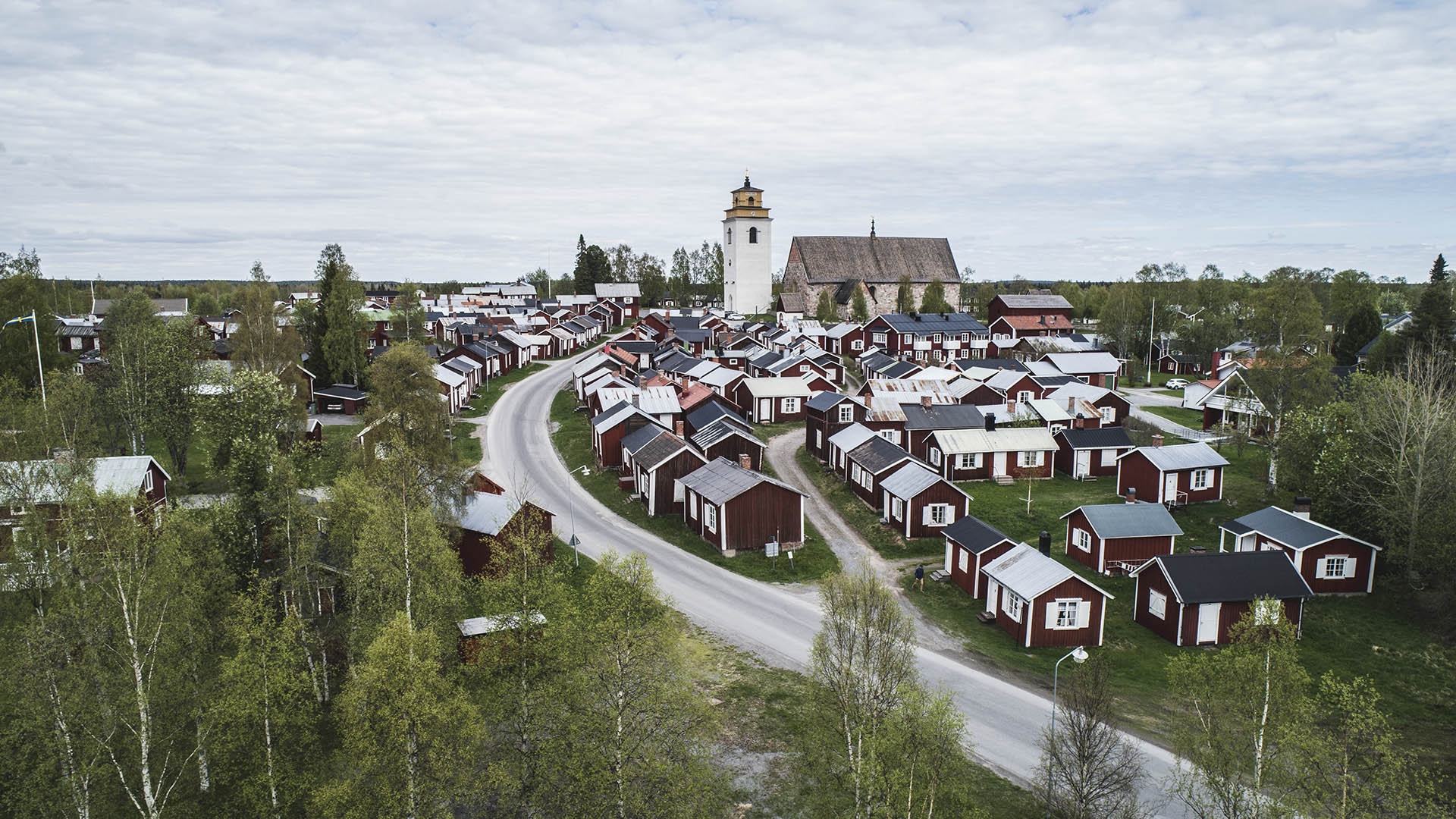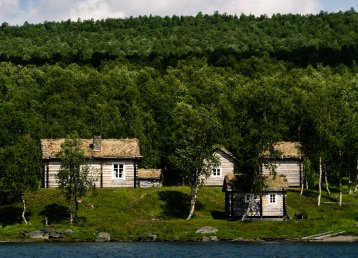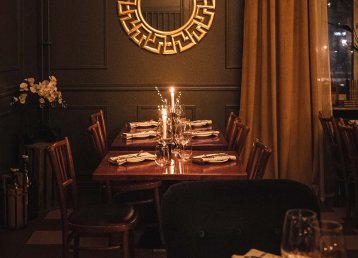Red log cabins in a kind of organised chaos around one of northern Sweden’s most beautiful churches – this might not be a completely accurate picture of World Heritage Gammelstad, but that’s what it feels like when you walk around the ‘town’ alleyways. Everything is neatly painted in that classic Swedish red colour, a kind of Nordic dream in pine.
If you stroll around the church village in the company of the guide Christoffer Svensson Ehlin, it’s very easy to start yearning for a journey in time. It makes you want to have been here back in the days when church duty made farmers haul themselves to church and service every Sunday, with courtship and partying as a bonus. If the farmer lived ten kilometres away, attendance was expected every weekend, and twenty kilometres meant every other weekend and so on. The further away, the less church duty. This caused another problem: it just wasn’t possible to travel back and forth on a Sunday for many of those living in the parish. Instead, they were allowed to build a house on land owned by the church. Suddenly church villages emerged. The most well-preserved one is Gammelstad outside Luleå.
A place to preserve
In Sweden, 16 church villages remain, and basically, all of them in the northernmost part of the country. 13 of them are found in the area that makes up the destination Swedish Lapland. From Ammarnäs in the mountains to Lövånger, in Skellefteå by the coast, up to Råneå, is where you’ll find most of them. Many of them have just a few or a dozen cottages, but Gammelstad church town outside Luleå consists of around 400 cottages and parish storage houses. Since 1996, Gammelstad church town is on the UNESCO World Heritage List, listing places worth preserving for the future.
Perhaps it sounds insanely dull to walk around listening to church history, but in the company of a guide, things are neither religious nor tedious – not at all.
– What do you think, they’ve given me the key to the Bell Tower so that we could go up there today, says Christoffer.
– It’s narrow and awkward, and we don’t usually take guests there, but I thought perhaps you might be interested in Luleå’s highest building built without the necessary permission.
Well, who wouldn’t be?
A lack of permission
The farmers around Gammelstad were wealthy. Salmon fishing in the Lule River was a massive source of income. In fact, speaking of moving towns as is the case in both Gällivare and Kiruna as a result of the mining business, that kind of move is nothing new in this part of Sweden. Back in the middle of the 17th century, people in Norrbotten county were forced to move the city of Luleå from its very location at Gammelstad to its present location at the mouth of the Luleå River. This was because the land rebound made the harbour in Gammelstad to shallow for ships to sail in and out and collect the salmon that had been caught. The silver salmon of the Lule River could be compared to the ore in the ore fields of today.
Anyway, these well-off citizens had commissioned a drawing from a local architect for a new bell tower they wanted to build. In Uppsala, however, where the drawings were supposed to be approved, they had different ideas about how it should look, and the drawings were redone. But when the new drawings came back to Gammelstad, someone put them in some dusty cupboard or other. Because the people of Luleå wanted it their way. Uppsala had no business interfering, so without permission and approved drawings, the bell tower in Gammelstad was built.
Also read
Discover Swedish LaplandStubborn farmers
Perhaps these farmers got away with their stubbornness just because of their healthy finances. Gammelstad’s church has stood here since 1492, and it’s beautifully adorned and well cared for. The altar cabinet tells the story of the suffering of Christ and is one of the finest in the country. It wasn’t ordered from somewhere next door; it came from Antwerpen where the best craftsmen worked, and cost 900 silver marks. It was a tremendous amount of money in 1520, but the farmers in the area are said to have paid it all cash and in advance.
Carl Linnaeus visited Gammelstad during his journey around Lapland 1732, and even if it was his Flora Lapponica that made his trip famous in scientific circles, his book Iter Lapponicum tells the story about a midsummer weekend and everything that goes with it. The Luleå River was a financial factor in the building of the Swedish state, and among other things, it was the money from salmon fishing up here that paid for Uppsala University. By way of anecdote, it’s said that salmon fishing in the Torne Valley once laid the foundation for the Swedish Academy’s treasure chest. So, this area has always been well-off.
In the bread-making hut
Strolling around the church village, you’ll almost always end up in the outdoor area Hägnan sooner or later. It’s a place many families with children are grateful for, as the area is excellent for entertaining even the youngest family members as they roam freely around the living countryside among animals and history.
In the old bread-making hut at Hägnan, the antiquarian Ann-Louise is baking bread. We’re invited into the hut, and it smells lovely. On the table, there is coffee, freshly-baked bread and butter. Ann-Louise rolls out the dough and says: “the better and more beautiful bread you bake, the better looking a partner you’ll get”.
And one thing is for sure: my man, he’s handsome.
A living cultural heritage
Today’s Gammelstad is a mix of cultural environment and living society. During certain periods the village comes to life. It resembles the olden days, such as during the traditional midsummer celebration when the entire area comes together to jump around a pole clad in leaves and flowers to the tune of ‘Little Frogs’, or the second Sunday of Advent when the annual Christmas market takes place at Hägnan.
There’s never that “museum-feel” to it, even if the Visitor Centre has an outstanding exhibition about the area and its history. Above all, it’s recommended to take a guided tour of the village. The guide Christoffer, who brought me up to the highest building in Luleå without planning permission, also shows me one of the cottages the Visitor Centre has at its disposal to share the history of the church village. It’s a large cottage that was used by a wealthy fur trader, but nowadays it’s an exhibition house. The coffee pot was a central item in those days – a tradition that’s still very much alive. Even if you weren’t allowed to cook on a Sunday, the day of rest, making coffee was an exception. The social network used to be somewhat more hands-on back then. During the big church weekends, people ran around, knocking on each other’s windows. If you could travel back in time, I’m sure you’d be standing outside a little red cottage, gently tapping a window. And if someone opened the window, you’d sing a song or recite a poem. Then, if you were lucky and did everything right, you might have been invited in for coffee and biscuits here among the church village’s red-painted dreams of pine.
Learn more
Gammelstad Church Town is one of 16 church villages that remain in Sweden. This place is also one of Sweden’s 15 UNESCO World Heritage Sites, sites worth preserving for the future. You can visit Gammelstad church village all year round, more information at visitlulea.se.
































